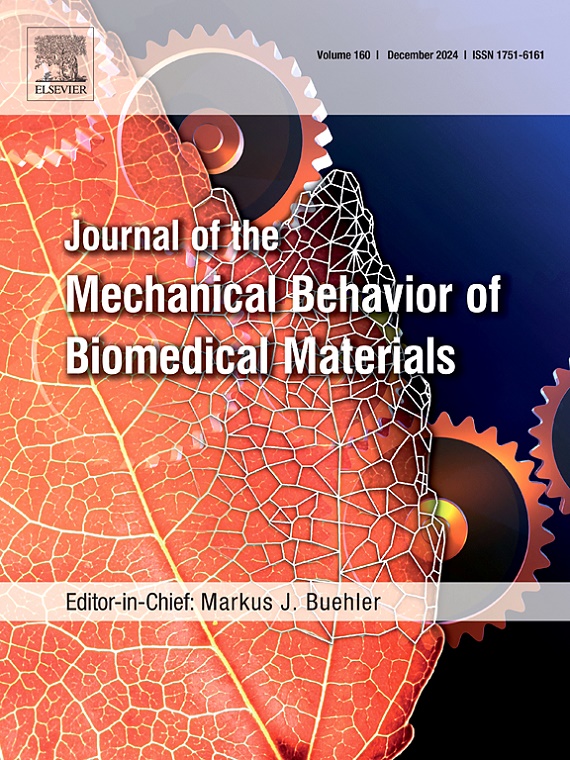Biomechanical testing of virtual meniscus implants made from a bi-phasic silk fibroin-based hydrogel and polyurethane via finite element analysis
IF 3.3
2区 医学
Q2 ENGINEERING, BIOMEDICAL
Journal of the Mechanical Behavior of Biomedical Materials
Pub Date : 2024-11-21
DOI:10.1016/j.jmbbm.2024.106830
引用次数: 0
Abstract
Objective
To investigate the suitability of different material compositions and structural designs for 3D-printed meniscus implants using finite element analysis (FEA) to improve joint function after meniscal injury and guide future implant development.
Design
This experimental study involved in-silico testing of a meniscus model developed from two materials: a specially formulated hydrogel composed of silk fibroin (SF), gelatine, and decellularized meniscus-derived extracellular matrix (MD-dECM), and polyurethane (PU) with stiffness levels of 54 and 205 MPa. Both single-material implants and a two-volumetric meniscus model with an SF/gelatine/MD-dECM core and a PU shell were analysed using FEA to simulate the biomechanical performance under physiological conditions.
Results
The hydrogel alone was found to be unsuitable for long-term use due to instability in material properties beyond two weeks. PU 54 closely replicated the biomechanical properties of an intact meniscus, particularly in terms of contact pressure and stress distribution. However, hybrid implants combining PU 54 with hydrogel showed potential but required further optimization to reduce stress peaks. In contrast, implants with a PU 205 shell generated higher induced stresses, increasing the risk of material failure.
Conclusions
FEA proves to be a valuable tool in the design and optimization of meniscal implants. The findings suggest that softer PU 54 is a promising material for mimicking natural meniscus properties, while stiffer materials may require design modifications to mitigate stress concentrations. These insights are crucial for refining implant designs and selecting appropriate material combinations before physical prototype production, potentially reducing costs, time, and the risk of implant failure.

通过有限元分析对由双相丝纤维素水凝胶和聚氨酯制成的虚拟半月板植入物进行生物力学测试
目的利用有限元分析(FEA)研究不同材料成分和结构设计对 3D 打印半月板植入物的适用性,以改善半月板损伤后的关节功能并指导未来的植入物开发。设计这项实验研究包括对由两种材料制成的半月板模型进行室内测试:一种是由丝纤维蛋白(SF)、明胶和脱细胞半月板细胞外基质(MD-dECM)组成的特殊配方水凝胶,另一种是刚度分别为 54 和 205 兆帕的聚氨酯(PU)。使用有限元分析法分析了单一材料植入物和具有 SF/ 凝胶/MD-dECM 内核和聚氨酯外壳的双体积半月板模型,以模拟生理条件下的生物力学性能。PU 54 密切复制了完整半月板的生物力学特性,尤其是在接触压力和应力分布方面。不过,结合了 PU 54 和水凝胶的混合植入体显示出了潜力,但需要进一步优化以降低应力峰值。与此相反,带有 PU 205 外壳的植入体会产生更高的诱导应力,增加材料失效的风险。研究结果表明,较软的 PU 54 是模拟天然半月板特性的理想材料,而较硬的材料可能需要进行设计修改,以减轻应力集中。这些见解对完善植入物设计和在物理原型生产前选择合适的材料组合至关重要,有可能降低成本、缩短时间并降低植入物失效的风险。
本文章由计算机程序翻译,如有差异,请以英文原文为准。
求助全文
约1分钟内获得全文
求助全文
来源期刊

Journal of the Mechanical Behavior of Biomedical Materials
工程技术-材料科学:生物材料
CiteScore
7.20
自引率
7.70%
发文量
505
审稿时长
46 days
期刊介绍:
The Journal of the Mechanical Behavior of Biomedical Materials is concerned with the mechanical deformation, damage and failure under applied forces, of biological material (at the tissue, cellular and molecular levels) and of biomaterials, i.e. those materials which are designed to mimic or replace biological materials.
The primary focus of the journal is the synthesis of materials science, biology, and medical and dental science. Reports of fundamental scientific investigations are welcome, as are articles concerned with the practical application of materials in medical devices. Both experimental and theoretical work is of interest; theoretical papers will normally include comparison of predictions with experimental data, though we recognize that this may not always be appropriate. The journal also publishes technical notes concerned with emerging experimental or theoretical techniques, letters to the editor and, by invitation, review articles and papers describing existing techniques for the benefit of an interdisciplinary readership.
 求助内容:
求助内容: 应助结果提醒方式:
应助结果提醒方式:


